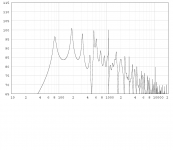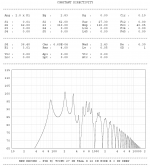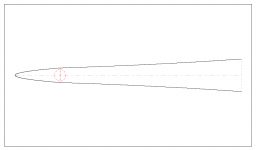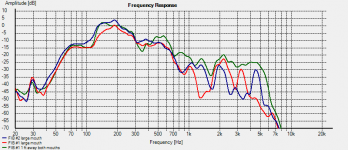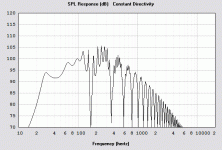Sure it can! When acoustically close to a more confining boundary the driver 'feels' a longer path-length, larger mouth horn same as a horn can be increasingly foreshortened, reduced in mouth area with increasing boundaries.
The only difference when the mouth is ‘gapped’ to another boundary is that due to the faster expansion it doesn’t begin to adhere to the simple +3 dB theoretically ideal gain with increasing boundaries until within a ¼ WL same as for summing multiple drivers.
GM
The only difference when the mouth is ‘gapped’ to another boundary is that due to the faster expansion it doesn’t begin to adhere to the simple +3 dB theoretically ideal gain with increasing boundaries until within a ¼ WL same as for summing multiple drivers.
GM
How much stuffing is usually required and where do you put it?
Stuffing density up at the peak down to below the driver will have the most impact over the widest BW, so where the initial testing should be optimized, then lining or light stuffing may be required to damp any parallel wall, mouth eigenmodes below this point.
No clue about the huge peak since I'm guessing this is up around where the 3rd harmonic dip [not peak] should be.
GM
FIB Sim in HornResp
I did a quick simulation of my FIB geometry in HornResp and got something pretty ugly. Is this typical for a BIB (the characteristic sound of a BIB)? Of course the peaks will be smoothed over somewhat with stuffing but the main result is that the circa 190 to 200 Hz bump is really just one of the main horn peaks above the fundamental. I don't think any amount of stuffing will make this less than the desired fundamental (confirmed with more measurements with added stuffing which only broadened and shifted the 200 Hz bump to the left). Listening to it though, honestly, it sounds pretty good nonetheless.
Can anyone else comment on their sims of the BIB, perhaps one in MJK with proper stuffing applied?
This may be the perfect thing to test a Karlson slot to see if it can reduce the second and third peaks.
I did a quick simulation of my FIB geometry in HornResp and got something pretty ugly. Is this typical for a BIB (the characteristic sound of a BIB)? Of course the peaks will be smoothed over somewhat with stuffing but the main result is that the circa 190 to 200 Hz bump is really just one of the main horn peaks above the fundamental. I don't think any amount of stuffing will make this less than the desired fundamental (confirmed with more measurements with added stuffing which only broadened and shifted the 200 Hz bump to the left). Listening to it though, honestly, it sounds pretty good nonetheless.
Can anyone else comment on their sims of the BIB, perhaps one in MJK with proper stuffing applied?
This may be the perfect thing to test a Karlson slot to see if it can reduce the second and third peaks.
Attachments
Last edited:
Flatter is Better Plan for Vifa TC9FD driver. What is not shown are numerous vertical braces every 2 to 3 inches, braces would be aligned parallel to direction of flow (diagonal in the corners). Probably 25 to 30 2 in wide x 4 in tall pieces of 3/16 in thick foam core braces glued with hot melt to back panel and then with PVA to front baffle. Use 90 deg square guide to ensure braces are vertical and square when fastening to back panel with hot melt glue. I would put stuffing in closed end and loosely up the 180 deg turn. Adjust to taste. I think that there may be extensive bass with this design and it may require more stuffing than usual.
For those wishing to build this out of wood. You can still use plywood (I would use 1/4 in thick to keep it light so it can be hung on wall). Use the foam core just for the internal diagonal as it is easy to curve by scoring lines on the concave side.
Hmm, I have one pair of Fostex FF85WK lying around. It's Qts is bit lower than Vifa TC9FD. I could try to build similar "FIB" from these.
Is BIB-calculator-sheet in any use of adjusting these measures?
Cheers,
hkk
GM,
My mistake, I had an incorrect setting (leftover driver-chamber from earlier sim with same driver) on the above sim. Here is the sim with what I think are the correct settings. Included are the dimensions and schematic. Does this look closer to a BIB? Note that I modeled the first part as a parabolic and the second part as an exponential to get the curves to behave the way the do on the as built unit. No attempt was made to deal with the split mouths. Horn output only.
My mistake, I had an incorrect setting (leftover driver-chamber from earlier sim with same driver) on the above sim. Here is the sim with what I think are the correct settings. Included are the dimensions and schematic. Does this look closer to a BIB? Note that I modeled the first part as a parabolic and the second part as an exponential to get the curves to behave the way the do on the as built unit. No attempt was made to deal with the split mouths. Horn output only.
Attachments
Last edited:
Hmm, I have one pair of Fostex FF85WK lying around. It's Qts is bit lower than Vifa TC9FD. I could try to build similar "FIB" from these.
Is BIB-calculator-sheet in any use of adjusting these measures?
Cheers,
hkk
I got my dimensions from the BIB calculator spreadsheet - based on driver Fs, Vas, Qts. The Fostex FF85WK should work very well in this and you will probably get a smaller cabinet than the Vifa as the volume scales with Qts to the 1.2 power, IIRC.
Update FIB Freq Response
Here are the latest results with more stuffing added. There are some differences between the two in the higher frequencies, may just be contamination from driver direct source, or it could be due to differences in the bracing and variability in stuffing. The 190 to 205 Hz peak has now broadened and shifted to the left. I am not sure what to do about it at this point - at least the two channels are somewhat balanced. I am open to suggestions as to how to fix.
Measurements were made 2 in away from mouth of large horn with speaker flat on floor (red and blue lines). Green line is 12 in away between large and small horn. 1/7th octave smoothing.
Here are the latest results with more stuffing added. There are some differences between the two in the higher frequencies, may just be contamination from driver direct source, or it could be due to differences in the bracing and variability in stuffing. The 190 to 205 Hz peak has now broadened and shifted to the left. I am not sure what to do about it at this point - at least the two channels are somewhat balanced. I am open to suggestions as to how to fix.
Measurements were made 2 in away from mouth of large horn with speaker flat on floor (red and blue lines). Green line is 12 in away between large and small horn. 1/7th octave smoothing.
Attachments
Hi Greg,
Thank you again,
I have now gone through all 500 plus pages.
Wow there is a lot of information here.
It's a nice problem to have.
I wish I had read this earlier.
Didn't have access to internet on the weekend and went and bought plywood and had it cut to spec. (Have a table saw but it's not easy manhandling a 4*8 sheet all by myself)
I was a little impatient to get started.
In an earlier post you said with regards to the FE206E that one should raise the qts in the spreadsheet to 3.5-4 and alter the dimensions. Or at least that is what I interpreted. From what I gather here, you are saying the same thing about the FE206EN.
Qts at .4 it gives me 18*25*76 (as opposed to 12*16*76)
Now that I have my wood cut, will it still sound okay?
I'm planning on building a wing for it and extend the front baffle.
Can I do anything to mitigate the lack of bass with the current dimensions.
The Bottlehead S.E.X. amps is well reviewed.
It is a stereo integrated single ended triode (SET) amplifier of 2 watts per channel output.
Terry Cain had ordered several units to go with his Abbys.
Single Ended eXperimenter's Kit
My current amp is a Cambridge Audio Integrated amp the Azur a540.
Cambridge Azur 540A integrated amplifier
Power output: 60Wpc into 8 ohms; 90W
into 4 ohms
I'm also playing with a sonic impact T-amp (the original)
A few pics of progress so far.
Chamfered out with a rasp that belonged to my great grandfather... Feels good to use his tools.
Sawtooth marks on barn lumber (not going to sand these out as they add to the character.)
Front baffle right side up.
-andré-
Thank you again,
I have now gone through all 500 plus pages.
Wow there is a lot of information here.
It's a nice problem to have.
I wish I had read this earlier.
Didn't have access to internet on the weekend and went and bought plywood and had it cut to spec. (Have a table saw but it's not easy manhandling a 4*8 sheet all by myself)
I was a little impatient to get started.
In an earlier post you said with regards to the FE206E that one should raise the qts in the spreadsheet to 3.5-4 and alter the dimensions. Or at least that is what I interpreted. From what I gather here, you are saying the same thing about the FE206EN.
Qts at .4 it gives me 18*25*76 (as opposed to 12*16*76)
Now that I have my wood cut, will it still sound okay?
I'm planning on building a wing for it and extend the front baffle.
Can I do anything to mitigate the lack of bass with the current dimensions.
The Bottlehead S.E.X. amps is well reviewed.
It is a stereo integrated single ended triode (SET) amplifier of 2 watts per channel output.
Terry Cain had ordered several units to go with his Abbys.
Single Ended eXperimenter's Kit
My current amp is a Cambridge Audio Integrated amp the Azur a540.
Cambridge Azur 540A integrated amplifier
Power output: 60Wpc into 8 ohms; 90W
into 4 ohms
I'm also playing with a sonic impact T-amp (the original)
A few pics of progress so far.
An externally hosted image should be here but it was not working when we last tested it.
Chamfered out with a rasp that belonged to my great grandfather... Feels good to use his tools.
Sawtooth marks on barn lumber (not going to sand these out as they add to the character.)
An externally hosted image should be here but it was not working when we last tested it.
Front baffle right side up.
An externally hosted image should be here but it was not working when we last tested it.
-andré-
Greets!
You’re welcome!
Hmm, best overall to tailor the speaker to the amp, i.e. build them too large acoustically, so that it won’t cause the flea power amp to ‘lay down’ trying to drive a smaller than optimum net Vb due to the amp’s high output impedance effectively weakening the driver’s motor [raising Qes/Qts].
lacking any SEX amp specs, I can only assume it’s a ~matching impedance, so using a ~0.4 Qts to calculate the BIB should be plenty high enough and if it should sound too ‘boomy’/’loose’ and/or has too much mid-range coming out the terminus with the higher DF amps, then you can either add some series resistance and/or more stuffing initially.
GM
Last edited:
Does this look closer to a BIB? Horn output only.
T.C.'s original RS 40-1354 BIB, 2pi horn only:
GM
Attachments
I am not sure what to do about it at this point - at least the two channels are somewhat balanced. I am open to suggestions as to how to fix.
What with no 1pi loading and no experience with the BIB per se [mine were all vent loaded and used a completely different design routine], much less a mid wall mounted one, no clue except to fiddle with stuffing and/or some sort of EQ.
Bottom line, a wall mounted one probably needs its own design routine.
GM
Hi Greg,
Thank you again,
I have now gone through all 500 plus pages.
Greets!
You’re welcome!
You’ve got more patience than me to actually read a 500 pg. Forum thread. A good book OTOH……
Right, using a medium Qts is pretty much my standard response and design choice for a low Qts driver if for no other reason than it makes the cab large enough for plenty of tuning flexibility.
Less bass is well, less bass and the only option would be to use digital EQ to trade efficiency for a flatter response to a lower corner frequency.
Again, I saw no output impedance/DF spec for the SEX amp, so have to assume it will be high enough to possibly create a ‘bloated’ bass response in an acoustically small cab/horn, though the other amps will theoretically do fine overall except for having less really deep bass than in a larger one.
Yeah, I prefer acoustic solutions to acoustic problems whenever practical, so typically want at least a 30” wide baffle to avoid using any BSC.
Ooh, my kind of woodworker! No ‘sissy’ router chamfering.
GM
Hi Greg,
For lack of a better word... BEURK
Hmmm... that's not very gratifying... My fault, I jumped in both feet.
Oh well, you pays your money and makes your choices.
What amp would you suggest to go with these?
Not afraid of getting my hands dirty and trying to solder a little.
If I'm not happy with the results, that this driver gives in this cabinet, I'll swap in another driver and
build a pair of Decaware HDT's for the Fostex206EN's
Audiophile Tube Amps and Tube Gear from DECWARE
Last night's progress:
Big chunky file used.
-andre-
For lack of a better word... BEURK
Hmmm... that's not very gratifying... My fault, I jumped in both feet.
Oh well, you pays your money and makes your choices.
What amp would you suggest to go with these?
Not afraid of getting my hands dirty and trying to solder a little.
If I'm not happy with the results, that this driver gives in this cabinet, I'll swap in another driver and
build a pair of Decaware HDT's for the Fostex206EN's
Audiophile Tube Amps and Tube Gear from DECWARE
Last night's progress:
An externally hosted image should be here but it was not working when we last tested it.
Big chunky file used.
-andre-
Greets!
You’re welcome!
You’ve got more patience than me to actually read a 500 pg. Forum thread. A good book OTOH……
Right, using a medium Qts is pretty much my standard response and design choice for a low Qts driver if for no other reason than it makes the cab large enough for plenty of tuning flexibility.
Less bass is well, less bass and the only option would be to use digital EQ to trade efficiency for a flatter response to a lower corner frequency.
Again, I saw no output impedance/DF spec for the SEX amp, so have to assume it will be high enough to possibly create a ‘bloated’ bass response in an acoustically small cab/horn, though the other amps will theoretically do fine overall except for having less really deep bass than in a larger one.
Yeah, I prefer acoustic solutions to acoustic problems whenever practical, so typically want at least a 30” wide baffle to avoid using any BSC.
Ooh, my kind of woodworker! No ‘sissy’ router chamfering.FWIW, I use a very coarse rasp as all those gouges and general irregularity help to further scatter any mids/HF reflections.
GM
What with no 1pi loading and no experience with the BIB per se [mine were all vent loaded and used a completely different design routine], much less a mid wall mounted one, no clue except to fiddle with stuffing and/or some sort of EQ.
Bottom line, a wall mounted one probably needs its own design routine.
GM
TC's BIB sim doesn't look that pretty either but at least the lower bass is a solid range rather than a couple of peaks. Looks like a lot of output in the 100 to 500 Hz range that needs to be attenuated with stuffing.
I think one thing I failed to consider when I first started designing the BIB for flatness is not looking at where the simulation peaks are and designing to avoid having standing wave resonances at the same frequencies.
I will play around with the stuffing some more and maybe try adding damping liners near the internal walls at the bottom.
TC's BIB sim doesn't look that pretty either but at least the lower bass is a solid range rather than a couple of peaks. Looks like a lot of output in the 100 to 500 Hz range that needs to be attenuated with stuffing.
No 'vent' only calculation looks very 'pretty'. What matters is the in room response of the combined driver/vent output once damped. WRT horn gain peaking, look at what can happen in room sim wise with a FE167E: http://www.quarter-wave.com/General/Fostex_FE-167E_BIB_Design.pdf
GM
What amp would you suggest to go with these?
Big chunky file used.
Greets!
That's the ticket! Sometimes we need to be coarse.
Well, either amp should do fine, though I would ‘test the boundaries’ of bass extension with the 540A by using cheap 25 ohm pots to dial in however much [if any] series resistance improves the overall performance and replace them with a fixed grid of small resistors.
Long term, either a matching impedance SET or low DF PP amp is what this horn driver wants to ‘feel’.
GM
Brillant! Thanks Greg...
Now I just have to finish the things.
Any suggestions with regards to wing/supra-baffle shape?
Total of 30 inches wide. Earlier in the thread someone, I forget who had good results with a trapezoid (pic not to scale)
but 6-7 inches wide (which would leave us somewhat short of 30inches.
Rectangular? Curved? (oblong oval)
Full length rectangle?
I'm gathering that round is bad.
I'll experiment but if pointed in the right direction it would save me time, material and money.
Pics of last night's progress...
Making a pattern to *enable* inside of the cabinet.
Going to plasticize it, cut out the squares and use a putty knife and plaster to apply it. (I don't have the patience to apply 14billion little squares of tape)
At least that is the plan.
We'll see how well it works in reality.
Hoping to get these up soon.
-andré-
Now I just have to finish the things.
Any suggestions with regards to wing/supra-baffle shape?
Total of 30 inches wide. Earlier in the thread someone, I forget who had good results with a trapezoid (pic not to scale)
An externally hosted image should be here but it was not working when we last tested it.
but 6-7 inches wide (which would leave us somewhat short of 30inches.
Rectangular? Curved? (oblong oval)
Full length rectangle?
I'm gathering that round is bad.
I'll experiment but if pointed in the right direction it would save me time, material and money.
Pics of last night's progress...
An externally hosted image should be here but it was not working when we last tested it.
Making a pattern to *enable* inside of the cabinet.
Going to plasticize it, cut out the squares and use a putty knife and plaster to apply it. (I don't have the patience to apply 14billion little squares of tape)
At least that is the plan.
We'll see how well it works in reality.
Hoping to get these up soon.
-andré-
Last edited:
- Home
- Loudspeakers
- Full Range
- Terry Cain's BIB -why does it work and does anyone have those Fostex Craft Handbooks?
